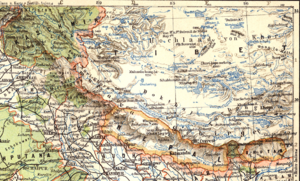Nepal–Britain Treaty of 1923 facts for kids
| Signed | 21 December 1923 (Paush 6, 1980 B.S.) |
|---|---|
| Location | Singha Durbar, Kathmandu, Nepal |
| Effective | 21 December 1923 |
| Condition | Recognition of Nepal as an independent and sovereign state by Great Britain. |
| Expiration | 31 July 1950 |
| Signatories | |
| Languages | Nepali, English |
The Nepal–Britain Treaty was a very important agreement signed on December 21, 1923. It happened in Singha Durbar, Kathmandu, Nepal. This treaty was the first time Britain officially said that Nepal was an independent country. It meant Nepal could make its own decisions about how it dealt with other countries. Many people saw this as a big success for Nepal's leader, Chandra Shumsher. The treaty was even recorded by the League of Nations in 1925.
Contents
Nepal's History and Independence
How Nepal Grew
Nepal's land has changed size many times throughout history. The country we know today started growing thanks to Prithivi Narayan Shah. He became king of Gorkha in 1743. At that time, Nepal was split into over 50 small kingdoms.
Prithivi Narayan Shah and the kings after him made the small state of Gorkha much bigger. At its largest, around 1810, Nepal stretched from the Sutlej River in the west to the Tista River in the east.
The Sugauli Treaty
After a war with the British, Nepal signed the Sugauli Treaty in 1816. This treaty made Nepal less independent. For example, it said that if Nepal and Sikkim had problems, the British East India Company would decide what to do. This made Nepal seem like it was partly controlled by the British.
The treaty also limited Nepal's ability to make its own foreign policy decisions. Plus, the British person living in Nepal was called a "Resident Minister," not an "ambassador." This also suggested Nepal was not fully independent.
Nepal and Britain Before 1923
After the Anglo-Nepalese War (1814–1816), Nepal and the British East India Company usually got along well. Their friendship became very strong when Jang Bahadur Rana was Nepal's leader.
Nepal even helped the British during the Sepoy Mutiny in 1857. Because of this help, Britain gave back some land to Nepal. These areas are now parts of Banke, Bardiya, Kailali, and Kanchanpur districts. They are known as "Naya Mulok" (New Country). Nepal also helped Britain in World War I. Overall, Nepal and Britain had a good relationship both before and after the 1923 treaty.
Making the Treaty Happen
Chandra Shamsher, who was Nepal's Prime Minister, really wanted Britain to officially recognize Nepal as an independent country. He knew the old Sugauli Treaty limited Nepal's freedom. He wanted Nepal to be seen as a completely sovereign state.
In 1921, when the Prince of Wales (who later became King Edward VIII) visited Kathmandu, Chandra Shumsher brought up the idea of a new peace treaty. British officials in Kathmandu, Nepal, and London talked about the treaty for over a year. Finally, it was signed on December 21, 1923, in Singha Durbar, Kathmandu.
What the Treaty Changed
This 1923 treaty was the first one between Nepal and Britain to be recorded by the League of Nations. It clearly showed Nepal's status to the rest of the world. The treaty officially declared Nepal an independent and sovereign state.
It was also the first treaty between Nepal and Britain that both countries discussed and agreed upon together. Nepali historians believe the main success of this treaty was protecting Nepal's independence. It also raised Nepal's standing among other nations. Many historians agree that this treaty was a major achievement for the Rana rulers of Nepal. After the treaty, the British representative in Nepal was no longer called a "Resident." Instead, they were called an "Envoy," which is a title used for representatives in independent countries.
See also
- Sugauli Treaty
- Nepal–Britain Treaty of 1860
- 1950 Indo-Nepal Treaty of Peace and Friendship
- Chandra Shamsher Jang Bahadur Rana


